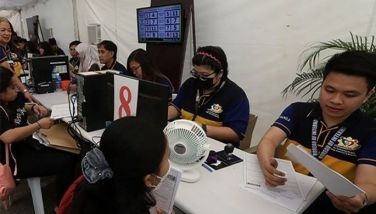Philippines take-off: Agri, shipping and tourism

How can the Philippines fly? This question without fail raises more questions, and I have yet to meet someone who can outline a plan that’s simple enough to understand and, more importantly, thoroughly convincing for me to buy in.
Sure, we need to boost our infrastructure network so that local businesses and foreign investors will be able to comfortably invest and grow the economy. Yes, we need to lower power rates so that our manufacturers can become more competitive vis-à-vis others in the region.
There are a hundred more other ingredients that need to be made ready, which includes both soft interventions (fiscal incentives, anti-corruption campaigns, improved education for our youth) as well as public investments.
But what exactly is the grand plan? Definitely, the government’s Build Build Build program is something worth supporting; making it happen in the best possible way is a challenge that the country’s leadership needs to tackle with unwavering resolve.
Bureaucratic gobbledygook
In the Philippine Development Plan (PDP) 2017 to 2022 overall strategic framework of the National Economic and Development Authority (NEDA), its seven parts and 21 chapters enumerate target outcomes, together with measurable indicators and desired levels.
On the other hand, the strategies to attain the target outcomes are supported by public investments listed in the Public Investment Program 2017-2022, a compendium of the government’s priority programs and projects that support the PDP.
Actually, the most palpable document by the government that contains a semblance of a plan to achieve the long-term vision of prosperity for the country would be the Philippine Inclusive Innovation Industrial Strategy or i3S, released by the Department of Trade and Industry.
But like the PDP 2017-2022, which incidentally contains a lot of gobbledygook, the i3S raises more questions – and can be confusing.
The i3S document is authored by DTI Assistant Secretary Rafaelita Aldaba as a policy brief, and champions a revival of the country’s manufacturing sector and strengthening its linkages with agriculture and services to create more and better jobs and attain inclusive and sustainable growth.
It argues that manufacturing resurgence is needed by the country to generate jobs for workers including those with low and semi level skills, who would eventually be able to earn more as they move up the labor skills level.
12 top priorities
Twelve subsectors are named as top priorities for industrial development. The development of the auto and auto parts industry is first on the list, presumably because of the success that came with the implementation of the Comprehensive Automotive Resurgence Strategy (CARS).
Other subsectors are electronic manufacturing services; aerospace parts and aircraft maintenance, repair, and overhaul; chemicals; shipbuilding and ship repair; furniture, garments, creative industries manufacturing and design; iron and steel, tool and die; agribusiness; construction; IT-BPM and e-commerce; transport and logistics; and tourism.
Too late or too early
One of the key questions that pops up in a manufacturing resurgence vision is its timeliness, or its being too late for the Philippines, having lost the momentum decades ago when Thailand, China and India succeeded and when we failed.
The three mentioned countries are emerging powerhouses now in the global auto industry, while our efforts with CARS at best hopes to improve local content of vehicles sold in the country – and definitely does not look at being a regional hub in the medium term.
The world’s automotive industry, in fact, is undergoing a radical change brought about by pressure to shift from engines that feed on fossil fuels to electricity, or even something that would totally change the propulsion system of vehicles.
The i3S impetus also singles out the importance of an agribusiness roadmap that focuses on strengthening production and agro-processing sectors. This would be timely if only we had a strong and robust agriculture sector. Before we talk about buying a cart, let’s make sure that we have the goods to load.
Finding one’s niche
We need to strengthen our agricultural sector, not primarily because of its export potential, but to secure our food supply especially with the growing number and severity of natural disasters not just affecting our country, but the whole world.
Shipping is one area that the government should prioritize, starting with ship repair and maintenance, and moving later into shipbuilding. Moving goods inter-island, and eventually to other countries, needs a strong nautical highway, something that’s appropriate for an archipelago like ours.
And yes, tourism should be part of the top three priorities, an area where we can comfortably compete once we install the proper infrastructure support like airports, seaports, roads, highways and bridges.
Culling those that are less important
Government would do best to leave the IT-BPM and e-commerce sector in the capable hands of the business process outsourcing industry, which has proven to be a responsible partner in the country’s economic development. And yes, let’s not rock the boat by withdrawing incentives it currently enjoys.
Let’s not stretch our meager resources by going into aircrafts, or chemicals, or iron and steel. Now is also no longer the time for resurrecting our furniture and garments industries.
Let’s recognize the transitory role that the construction industry played during the recent real estate boom, and the forthcoming golden age of infrastructure, i.e., to provide temporary employment for blue collar workers.
Prioritizing
Let’s limit priorities to a maximum of three. It should be easier to manage, would allow us to focus better, and should unleash greater power from all the investments that the government has outlined in the next six to 25 years.
Facebook and Twitter
We are actively using two social networking websites to reach out more often and even interact with and engage our readers, friends and colleagues in the various areas of interest that I tackle in my column. Please like us at www.facebook.com and follow us at www.twitter.com/ReyGamboa.
Should you wish to share any insights, write me at Link Edge, 25th Floor, 139 Corporate Center, Valero Street, Salcedo Village, 1227 Makati City. Or e-mail me at [email protected]. For a compilation of previous articles, visit www.BizlinksPhilippines.net.
- Latest
- Trending

























